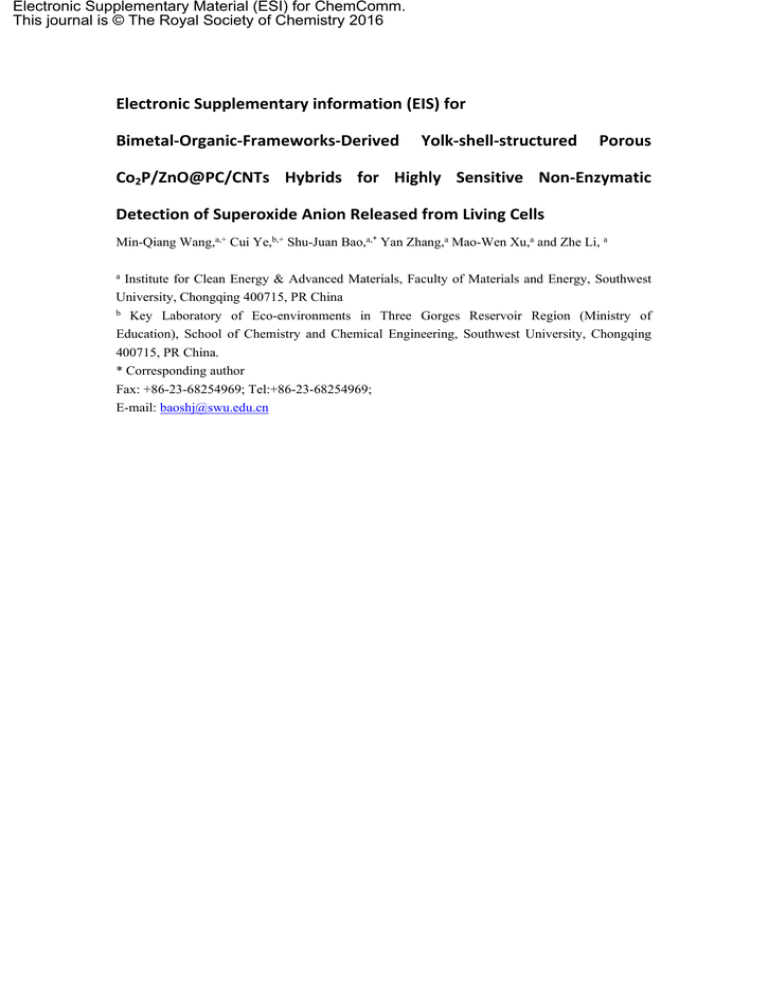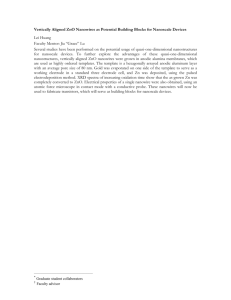Electronic Supplementary information
advertisement

Electronic Supplementary Material (ESI) for ChemComm. This journal is © The Royal Society of Chemistry 2016 Electronic Supplementary information (EIS) for Bimetal-Organic-Frameworks-Derived Yolk-shell-structured Porous Co2P/ZnO@PC/CNTs Hybrids for Highly Sensitive Non-Enzymatic Detection of Superoxide Anion Released from Living Cells Min-Qiang Wang,a,+ Cui Ye,b,+ Shu-Juan Bao,a,* Yan Zhang,a Mao-Wen Xu,a and Zhe Li, a a Institute for Clean Energy & Advanced Materials, Faculty of Materials and Energy, Southwest University, Chongqing 400715, PR China b Key Laboratory of Eco-environments in Three Gorges Reservoir Region (Ministry of Education), School of Chemistry and Chemical Engineering, Southwest University, Chongqing 400715, PR China. * Corresponding author Fax: +86-23-68254969; Tel:+86-23-68254969; E-mail: baoshj@swu.edu.cn Experimental section Materials: Analytical grade cobalt nitrate hexahydrate (Co(NO3)2·6H2O), zinc nitrate hexahydrate (Zn(NO3)2·6H2O), 2-methyllimidazole and Nafion solution (5 wt %) were purchased from Aladdin Industrial Co., (Shanghai, China). Potassium superoxide (KO2), Zymosan A (Zym, from Saccharomyces cerevisiae), SOD (from bovine erythrocytes), and 0.01 M PH 7.4 Phosphate buffer solution (PBS) were obtained from Sigma-Aldrich. The O2•− solutions were prepared by the addition of KO2 solid powder to PBS (N2 saturated). The concentration of O2•− was determined by recording the reduction of ferri cytochrome c spectrophotometrically and using the extinction coefficient (21.1 mM−1 cm−1) of ferri cytochrome c at 550 nm. The other chemicals were purchased from Sigma-Aldrich and used without further purification. Deionized water (18.2 MX) was used throughout the experiments. Synthesis of Zn/Co-ZIF and ZIF-67 precursors: The Zn/Co-ZIF precursors were first synthesized via a simple method according to the previous report. In a typical synthesis, 2methyllimidazole (0.616g), Co(NO3)2·6H2O (0.546g), and Zn(NO3)2·6H2O (0.558g) were dissolved in 15mL methanol, 7.5mL methanol, and 7.5mL methanol, respectively under ultrasound for 5min at room temperature. After forming homogeneous solution, Co(NO3)2·6H2O in methanol solution was mixed with ligand solution (2-methylimidazole) slowly in 1min under ultrasound for 2 min at 40℃ by syringe. Next, Zn(NO3)2·6H2O in methanol solution was further added in the above-mentioned solution by inches keeping ultrasound for 10min. The resulting suspension was transferred to 50mL Teflon-lined stainless-steel autoclaves and then heated at 120℃ for 4h. Finally, the mixture were washed via centrifugation at 11000 rpm for 5 min with methanol for several times and then dried under vacuum at 60℃ to get the final Zn/Co-ZIF product. For the synthesis of ZIF-67, the same procedure was conducted without the addition of Zn(NO3)2. Synthesis of Co2P/ZnO@PC/CNTs and Co2P@PC: The Co2P/ZnO@PC/CNTs was prepared by using a simple low-temperature phosphidation of the obtained Zn/Co-ZIF precursors. In a typical synthesis, 20 mg Zn/Co-ZIF precursors and 400 mg NaH2PO2 were placed at two separate positions in one quartz boat with NaH2PO2 at the upstream side of the furnace. Then, the samples were heated to 350 ℃ for 1.5 h with a heating rate of 2 ℃min-1 in a N2 atmosphere. After cooling to room temperature, the porous Co2P/ZnO@PC/CNTs was collected. The same procedure was conducted to fabricate Co2P@PC used ZIF-67 as precursor. Fabrication of modified electrodes: The glassy carbon electrode (GCE, Φ= 3 mm) was respectively polished with 0.3 and 0.05mm alumina slurry followed by rinsing thoroughly with double distilled water, and then ultrasonically cleaned in ethanol and double distilled water to obtain a mirror-like surface. The as-prepared Co2P/ZnO@PC/CNTs aqueous dispersion (5mL, 2 mg ml-1) was dropped onto the well-polished bare GCE and then evaporated in air. Then, Nafion (5mL, 2.5%) was dropped on the surface of Co2P/ZnO@PC/CNTs composite to form a Nafion membrane. Similar procedure was also applied to prepare Co2P@PC modified electrode for a comparative study. Material characterizations and electrochemical measurements: Powder X-ray diffraction (XRD) patterns were obtained with a XRD-7000 (XRD, Shimadzu XRD-7000) with Cu Kα source radiation at a scanning rate of 2° min−1 from 10 to 80°. The morphologies and microstructures were investigated by field-emission scanning electron microscopy (FESEM, JEOL-7800F), transmission electron microscope (TEM, JEM- 2100), and Energy-dispersive X-ray spectroscopy (EDX, INCA X-Max 250). The surface properties of the samples were studied by X-ray photoelectron spectroscopy (XPS, Escalab 250xi, Thermo Scientific). The electrochemical measurements were carried out on a conventional three electrode system with the as-prepared electrodes as the working electrode, a platinum wire as the counter electrode, and a saturated calomel electrode (SCE) as the reference electrode on a CHI660 electrochemical workstation (CHI Instruments Inc.). Cell Cultures and real time monitoring cell released O2•− molecules: A375 (human malignant melanoma cells) cell line was cultured in RPMI-1640 medium supplemented with 10% heat inactivated fetal bovine serum, 1 mol L−1 ampicillin and 1 mol L−1 kanamycin and was grown in a humidified incubator (95% air with 5% CO2) at 37 °C. The cell density applied to our experiments was the average cell number counted from 6 different areas of 1.8 mm2 on three samples through inverted microscopy. Real time monitoring O2•― molecules released from cells was performed by chronoamperometry. In order to ensure accuracy of measured O2•― concentrations, cell culture medium inside device was mildly stirred during cell released O2•― measurement Fig. 5. The electrochemical impedance spectroscopy (EIS) of Co2P/PC and Co2P/ZnO@PC/CNTs hybrid based electrodes in a 0.2 M [Fe(CN)6]3-/4- mixture (1:1) containing 0.1 M KCl at open potential.
